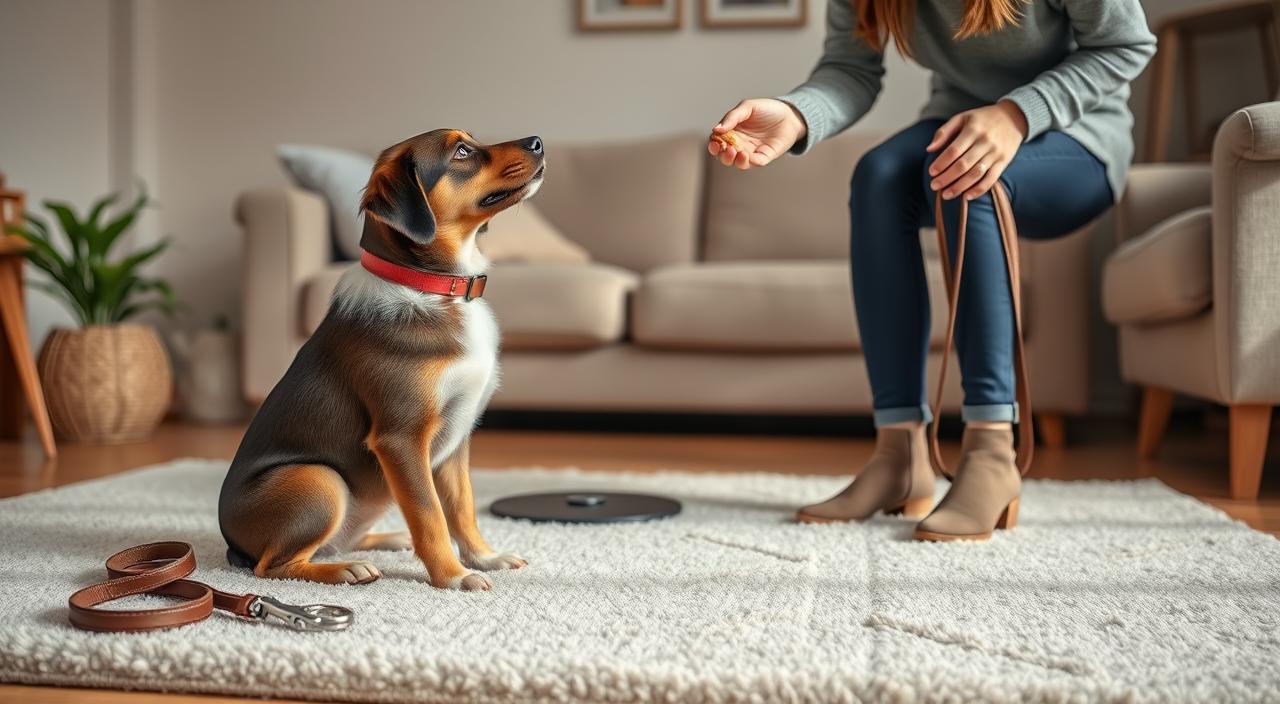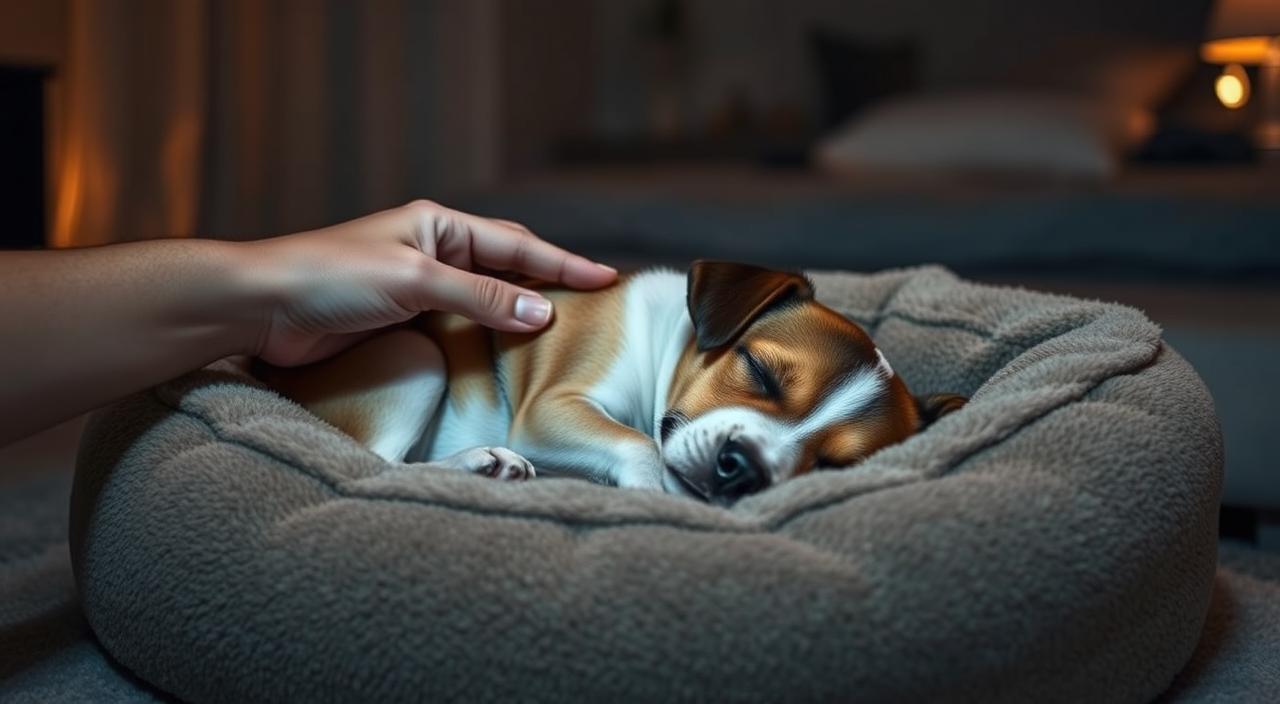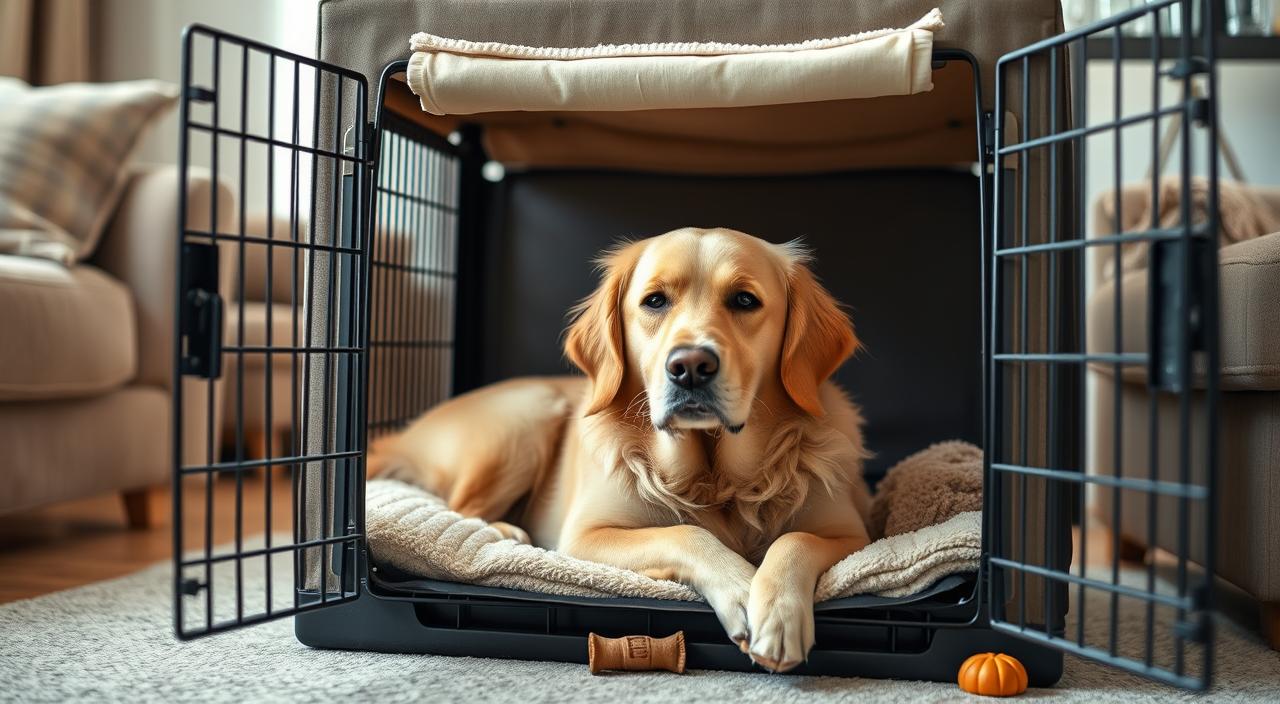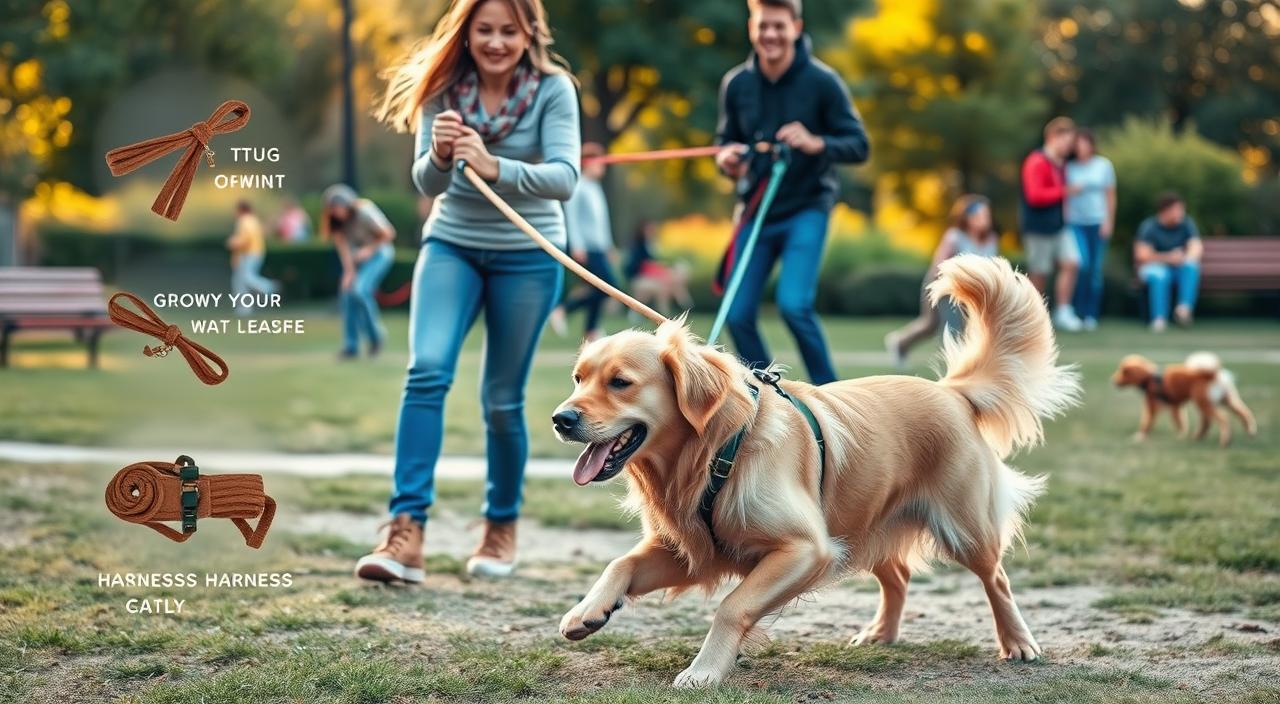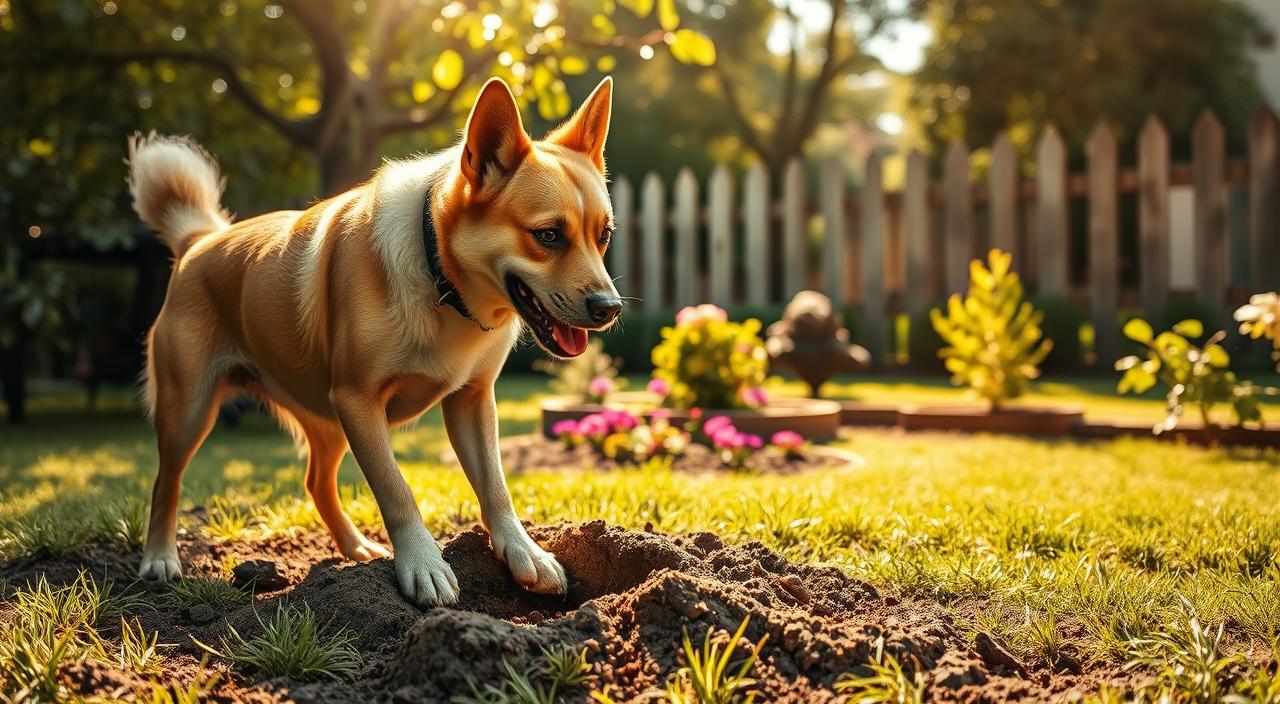Nearly one in four dogs can carry heightened arousal chemicals for up to 24 hours after an exciting event — a single busy afternoon can shape tomorrow’s behavior.
This guide sets a realistic expectation: calm builds through daily routines, thoughtful management, and small, repeatable steps rather than a quick fix. We explain both conditioning an emotional state and teaching a clear cue the dog can perform.
Readers will learn practical ways to reduce triggers at home — window film, white noise, gates — and simple mat work that travels. Food rewards with precise timing, then fading to petting and praise, form the core training tools.
Door and guest strategies focus on safety first: a leash by the door, baby gates, or a crate with a stuffed Kong keep people and pets comfortable while skills develop. This advice aims to help dog owners implement steady, humane changes today.
Key Takeaways
- Calm is created by routine and management, not one session.
- Reduce household triggers and plan calmer days after big outings.
- Use food rewards with good timing, then transition to praise.
- Teach a portable mat/place behavior for relaxation around people.
- Prioritize safety at the door with a leash, gate, or crate.
- The aim is relaxed, not suppressed, behavior through humane methods.
Calm isn’t a command: understand emotion versus behavior
Calm grows like a habit: small, predictable events cue the brain to settle. This section explains why feeling relaxed and standing still are not the same.
Conditioning calm targets the mind and body. Training a behavior teaches an action the dog will perform on cue. Both matter, but they are different skills.
Conditioning calm feelings vs. training calm behaviors
Think of rooms as settings: one can feel like a quiet church while another feels like a loud concert—this simple example shows how context shapes response. Owners can make the house feel restful by pairing a mat, soft voice, and gentle petting so the body learns safety there.
Exercise the body and engage the mind before asking for rest. A short run or scent game helps the dog release energy so settling is possible.
Why this distinction changes your plan
If you only teach “not moving,” the animal may freeze while staying tense. Conditioning calm means breathing slows, muscles soften, and the dog behavior truly relaxes.
- Preconditions: physical and mental outlets before rest.
- Trainer tip: pair mat work with calm strokes and a quiet cue over low-pressure reps.
- Breed and temperament matter—high-drive breeds need more enrichment before rest feels natural.
- House management: quieter rooms and routines speed conditioning.
| Focus | Goal | Signs | Tools |
|---|---|---|---|
| Conditioning calm | Inner relaxation | Slow breathing, soft body | Mat, massage, quiet voice |
| Training behavior | Reliable action | Placed, stationary posture | Clicks, rewards, repetition |
| House management | Lower baseline arousal | Fewer triggers, calm routines | Gates, white noise, predictable schedule |
Build the foundation: exercise the body, engage the mind
When movement and mental work are predictable, dogs settle faster and more reliably. This section outlines simple, repeatable activities owners can use each day.
Physical outlets that actually take the edge off
Prioritize exercise that truly lowers energy: structured leash walks, fetch or tug with brief pauses, and, for healthy adult dogs, occasional backpack walks to add effort without extra time.
Avoid busy dog parks that spike arousal; choose a compatible playmate or solo games you can stop and start.
Simple mental workouts that satisfy the brain
Short obedience drills on walks, food puzzles, scent searches, and easy tricks give the mind work that reduces restlessness later in the day.
Insert breaks during play—stop briefly, then resume—so the pup learns to shift gears between excitement and rest.
Knowing breed, age, and energy profile
Match session length to breed and age: young pups need frequent short reps; adult dogs often benefit from longer, steadier routines. Gentle exposure to people at a distance and calm rewards help generalize relaxed behavior outside.
- Keep recalls positive: call for a quick reward, then allow more play.
- Plan consistent times each day—predictability lowers baseline arousal and makes rest easier.
| Need | Example | Benefit |
|---|---|---|
| High energy | Backpack walk, fetch with breaks | Burns more energy in less time |
| Mental outlet | Food puzzles, scent games | Reduces restlessness later |
| Social exposure | Calm meetups, distant greetings | Generalizes calm around people |
Lower arousal in everyday life to make calm possible
Small changes around the house can stop repeated spikes of excitement before they start. Owners can block sights and sounds that keep the nervous system primed. That makes it easier for a dog to unwind later.
Blocking arousal triggers at home
Reduce sightlines to passing people or animals. Use baby gates, close blinds, or add decorative window film so delivery trucks or street dogs do not spark repeated barking.
Dampen sound during known trigger time windows with classical music or a white noise machine. Lowering acoustic input reduces surprise reactions that keep arousal cycling.
Play with breaks: teaching the shift from hype to mellow
Replace chaotic outings with controlled activities. Try fetch in a hallway, tug with clear start/stop rules, or calm sniff walks. These let dogs practice downshifting.
- Keep a leash handy for quick, calm control in doorways or busy moments.
- Build pause points into play: brief sits or downs, then resume play.
- Track times and things that set your pet off, and plan around them.
- Use management to stop dog rehearsals of problem patterns quickly—prevention protects progress.
| Trigger | Simple fix | Benefit |
|---|---|---|
| Visual | Window film or blinds | Fewer starts and less barking |
| Noise | White noise or music | Reduced surprise reactions |
| Play | Structured games with breaks | Teaches self-control over time |
Shape default calm: capture sits, downs, and quiet moments
Catching brief, relaxed actions and reinforcing them turns quiet moments into habits. Keep pea-sized treats in common areas so rewards happen the instant a desirable behavior appears.
Start with frequent, consistent positive reinforcement: mark a calm sit or down with a quick sound or word, then give a tiny treat. Over days, make rewards unpredictable and then fade to slow praise or petting so calm becomes its own payoff.

Ignore attention-seeking antics. Turn away from jumping and withhold touch until all four paws are on the floor, then mark and reward that choice. If the dog grabs an item, trade rather than chase—offer something better and say “drop” as you exchange.
- Catch your dog doing something right—sit, down, or looking away from triggers—and reward immediately.
- Use positive reinforcement heavily at first, then randomize reinforcement and shift to praise.
- Keep treats handy so reinforcement happens in real time, not minutes later.
- Reinforce calm choices like self-directed mating, quiet lying, or disengaging from a window.
| Action | Simple step | Benefit |
|---|---|---|
| Mark sits/downs | Immediate small treat | Builds default calm |
| Ignore jumping | Turn away until paws down | Stops rehearsed attention-seeking |
| Trade items | Offer better item, say drop | Prevents chase and conflict |
Weave these short, frequent moments into daily life and combine them with basic management—put tempting objects away and block access to hot spots—so training pays off faster and more reliably. These steps will help teach dog calm behavior without long sessions.
Clicker and marker training for split-second moments of calm
Markers give owners a precise way to mark the exact instant a dog chooses calm, then link that moment with a meaningful reward.
Timing calm with a click, “YES,” or mouth click
Start by charging your marker: ten quick click-then-treat reps so the sound predicts a reward every time. This builds clarity and trust.
Use the marker for split-second calm—when the dog’s butt hits the ground, when four feet stay on the floor, or when barking pauses. Precision matters more than volume.
Choose the tool your pet likes: a quiet I-clicker, a cheerful “YES,” or a mouth click. If the clicker startles the dog, switch tools and stay consistent.
Fading food to petting, praise, and toys
Provide an example: the moment the butt touches the mat, click, then deliver a treat. Tight timing teaches exactly which behavior earns the payoff.
Fade food slowly—move from treats to slow petting, soft verbal praise, or a calm toy toss as calm becomes reliable. During heavy distractions, bring back special treats briefly.
- Keep sessions short and upbeat: two minutes of clean reps beats ten minutes of sloppy timing.
- Don’t stop the marker too soon; trainers value markers because they bridge action and reward.
- Match rewards to preference so motivation stays high and training remains effective.
| Step | Action | Benefit |
|---|---|---|
| Charge marker | 10 quick click+treat reps | Sound predicts reward |
| Mark moment | Click at butt down or four feet on floor | Precise learning |
| Fade rewards | Shift treats → petting/toy | Longer, natural calm |
How to Train a Dog to Stay Calm: a step-by-step plan
Breaking goals into tiny steps lets owners build reliable relaxation without stress or confusion. This short plan shows one clear way to pick a target, shape progress, and keep everyone consistent.
Decide the exact behavior you want
Pick one clear target behavior—lie on a mat with head down or settle at your feet. Write it down so every household member uses the same criteria.
Start easy, then layer in time, distance, and distractions
Begin in a quiet room. Run a short session capturing small steps toward the goal. Mark and reinforce each success.
- Add time in seconds, then distance, then light distractions—only progress when the behavior is calm.
- If the dog breaks, guide back calmly, lower the criteria, and mark the next clean rep—no scolding.
- Use low- to medium-value food for relaxation work; save higher-value rewards for harder contexts.
- Track weekly time goals (for example: five relaxed minutes) and add doorbell or family movement later.
| Step | Cue | Trainer tip |
|---|---|---|
| Pick target | Mat or spot | Write criteria clearly |
| Quiet shaping | Short reps | Mark early progress |
| Increase challenge | Time → distance → distractions | Only advance after calm reps |
| Reset | Calm guidance | Reduce criteria, try again |
Teach “place” and mat relaxation your dog can take anywhere
A simple mat and a consistent cue can give dogs a portable safe spot wherever life takes them. This skill trains both body and mind to unwind in new settings.
Go-to-mat basics and settling without constant cues
Introduce the place by tossing a treat onto the mat while you say the cue once. Click as the dog steps on, then let them eat there so the mat gains value fast.
If the animal watches for treats and gets wired, pause. Wait for a visible softening — a blink, a sigh, or a relaxed hip shift — then mark that moment.
Using tethers wisely, then fading to off-leash calm
Start with a light leash or tether beside your chair for safety and clearer feedback. Click for self-initiated settling and ignore restlessness until true calm appears.
Stretch session time slowly. When your pup rests calmly for about ten minutes, remove the tether and keep occasional reinforcement.
Relaxation protocols to lengthen calm duration
- Layer small movements: stand, sit, step away, return — reward calm, not perfection.
- Use a structured relaxation protocol (for example, Karen Overall’s) to add duration and mild distractions in stages.
- Practice briefly but often so the mat becomes a reliable anchor for vet visits or family rooms.
| Step | What it teaches | Quick tip |
|---|---|---|
| Introduce place | Value on the mat | Click as paws hit mat |
| Leash start | Safe fading to off-leash | Ignore fidgeting, mark calm |
| Time build | Longer calm behavior | Add one minute increments |
With steady, short sessions and clear cues, a single mat becomes an anchor. Trainers often note that consistent practice makes the mat a cue for true dog calm rather than a command that forces stillness.
Polite door greetings: from chaotic to composed
Doorway moments are a predictable challenge. With a simple routine, families can turn arrivals into calm practice instead of a loud disruption.
Leash at the door and a pre-arrival plan
Clip a leash on before you open. Review the plan: stand upright, cue a sit or send the dog to its place, and only open the door when there is control.
Keep high-value treats handy for quick reinforcement. If control is uncertain, start with the pet in a crate or separate room and greet people first.
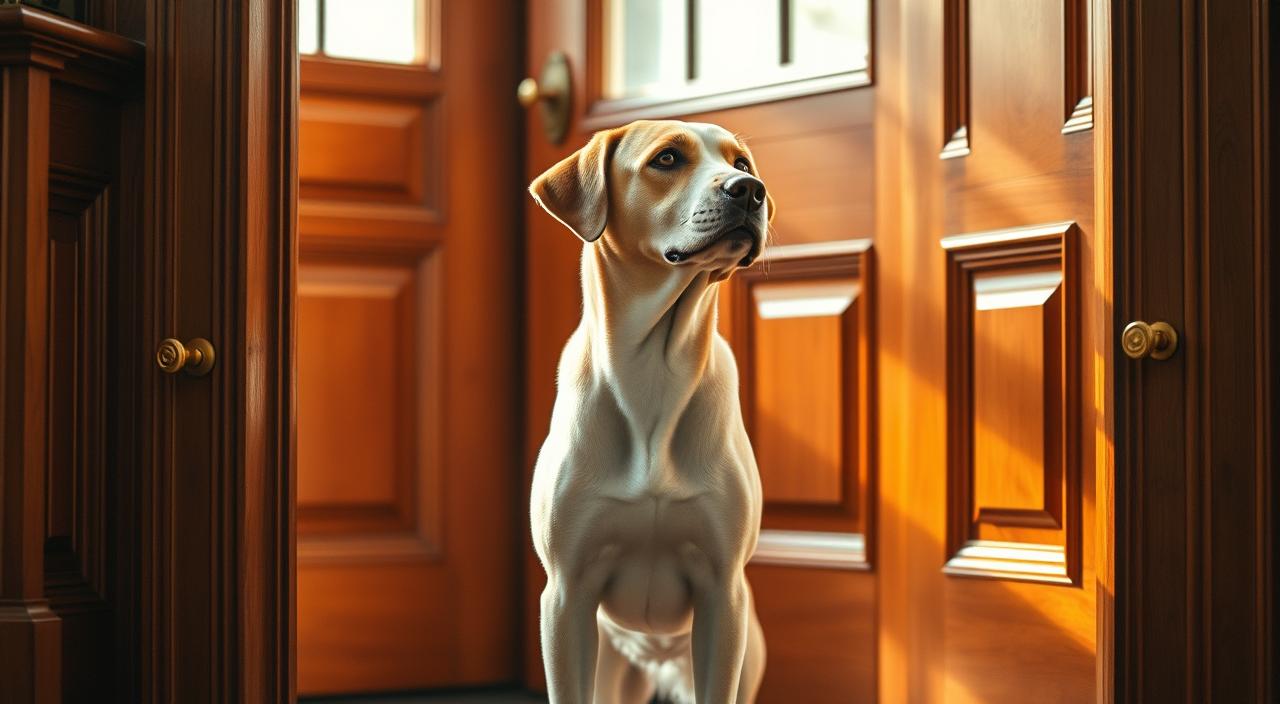
Guest instructions: ignore first, reward calm later
Ask visitors to ignore the dog for the first moments—no eye contact, no squeals, hands off. This removes the biggest trigger for jumping and barking.
When the dog offers four paws on the floor or a quiet sit, mark that instant and reward with one treat or a calm “good.” Turn away during jumping and only interact when the dog is settled.
Group walk and gradual introductions for new people
A short group walk before prolonged contact helps. Light exercise and neutral space make new people ordinary and lower arousal in the house.
Keep initial sessions brief. Rotate the dog back to its safe place to decompress rather than letting excitement build; repeat short exposures and use positive reinforcement strategically.
- Clip leash before the knock; review control plan.
- Guests ignore first; reward quiet sits later.
- Use crate or separate room if needed; greet visitors first.
- Take a brief group walk with guests to burn off energy.
| Start | Tactic | Benefit |
|---|---|---|
| Pre-arrival | Leash on, plan review | Immediate control at the door |
| Greeting | Guests ignore, reward calm | Limits jumping and barking |
| Introduction | Short walk, then supervised meet | Neutralizes arousal, builds safe associations |
Manage the environment so calm wins by default
Designing rooms and routines can make low-energy behavior the easy default. Management is prevention: small adjustments in the house change daily outcomes and reduce stress for everyone.
Crates, gates, and safe spaces stocked for decompression
Create a quiet home base with a crate or gated room and a comfy place your dog already trusts. Stock that space with decompression things—a stuffed Kong, safe chews, and a favorite blanket—so the nervous system can downshift quickly.
- Use gates to block windows or busy rooms; this gives owners effortless control without constant micromanagement.
- Keep a leash by the door and follow a short arrival plan—clip on, cue the place, then open—so the family can prevent most doorway scrambles.
- Adjust the house: apply window film, close blinds at peak times, and run white noise during known triggers.
- Make predictable patterns: rest after walks, chews after training, and a calm routine after meals so dogs learn what comes next.
| Tool | Use | Benefit |
|---|---|---|
| Crate or gated room | Quiet place for decompression | Safe, consistent place for rest |
| Stuffed Kong & chews | Long-lasting focus during arrivals | Occupies mouth and calms nerves |
| Window film & white noise | Reduce sights and sounds | Lower baseline arousal |
Align the family on rules and routines—calm greetings, no roughhousing in the entryway—so everyone sends one clear message. This simple way of managing the environment helps dog behavior become steady, not a constant struggle.
From puppies to adults: tailoring sessions and expectations
Puppies and mature dogs need different plans. Pups learn through short, playful reps and many naps. Adults usually respond best to steady routines that balance exercise, training, and rest.
Short, playful reps for pups
Design each pup session to be brief and fun. Try two minutes of mat work, a play break, then another minute of calm. These tiny wins stack into real habits.
Young animals need frequent downtime. A well-timed nap often fixes over-excitement faster than more practice. Keep expectations forgiving and build slowly.
Structured practice for grown dogs
Adults benefit from consistent blocks of activity. Schedule exercise, mental work, and rest so energy ebbs and flows predictably through the day.
- Match outlets to breed tendencies—high-drive breeds often need richer scenting or puzzle games.
- Keep time goals modest: many short successes are better than forcing long holds.
- Use lower-value food or calm petting during relaxation reps so arousal stays down.
| Age | Focus | Quick tip |
|---|---|---|
| Pup | Short sessions, naps | 2 min work, then play |
| Adult | Routine, mental outlets | Set regular exercise blocks |
| All | Energy management | Adjust outlets before calm work |
If an adult struggles to settle, review foundational outlets—more mental work or a better pre-rest walk may help dog settle faster. Progress comes with maturity; gentle routines will help dog and owner alike.
Read body language, use consistent cues, and stick to routine
Reading a dog’s subtle signals gives owners a clear roadmap for preventing overexcitement before it starts. A short habit—watching posture, breathing, and tail carriage—lets families intervene early and keep interactions calm.
Common cue words that prevent jumping and barking
Standardize simple cues across the household so everyone gives the same message. Use low, steady tones: say “wait” at doors, “easy” to slow movement, and “settle” for lie-down-and-relax.
- Watch body language: soft eyes and slow breathing show relaxation; tight muscles or a high tail signal rising arousal.
- Ask guests—especially new people—to ignore the dog at first and avoid eye contact or excited greetings.
- Stand upright and remain calm at the door; posture reduces jumping and gives clear control for people arriving.
- Practice short rehearsals during quiet times: a few minutes daily builds fluent behavior without pressure.
- Mark and reward calm behavior immediately so the dog links the quiet choice with attention or a small treat.
- If timing and reading signals feel hard, consult trainers or a class for quick, useful feedback.
| Focus | Simple step | Benefit |
|---|---|---|
| Body language | Look for soft eyes, relaxed jaw | Early intervention |
| Consistent cues | Use “wait,” “easy,” “settle” | Clear expectations |
| Routine | Fixed walks, meals, rest | Lower baseline arousal |
Conclusion
Practical daily habits give dogs a clear path toward relaxed behavior in the home.
Good advice pairs outlets and simple management so calm becomes the easy choice for dog owners. Manage sights, sounds, and routines to reduce common issues and keep arousal low.
Use precise timing—a clicker or quick mark—then a reward so learning is clear. Short reps of mat work help; teach a reliable place that moves with your family and supports dog calm in new settings.
Keep sessions brief, align cues with others in the house, and give dog steady sleep, exercise, and mental work. For ongoing issues, consult a positive reinforcement trainer or veterinary behaviorist.
Small wins add up: softer posture, faster settling, and more peaceful time with people and pets.

